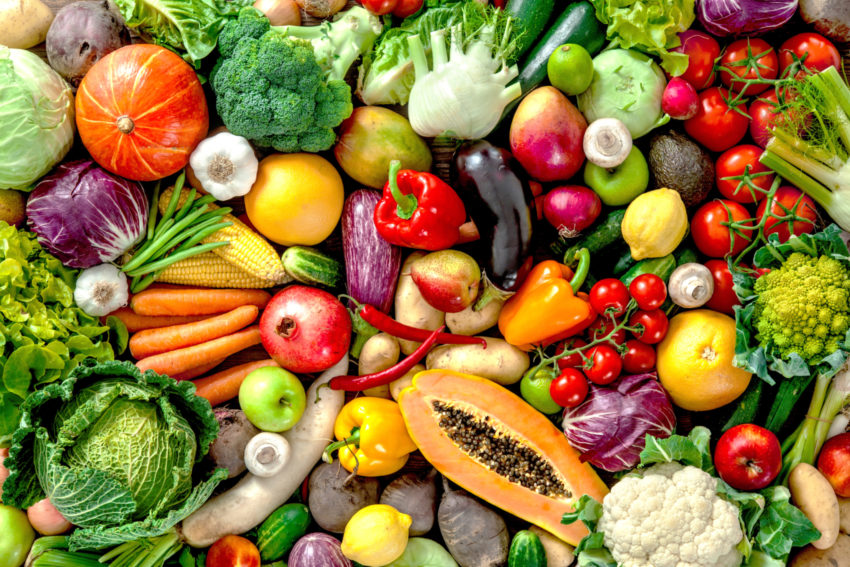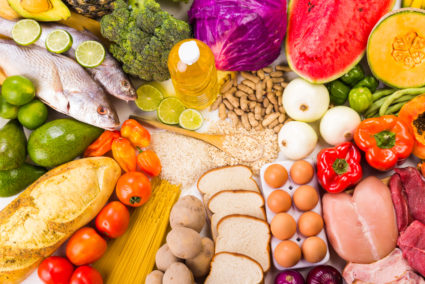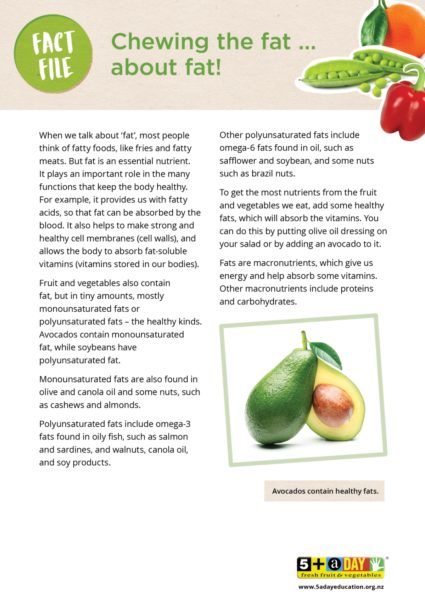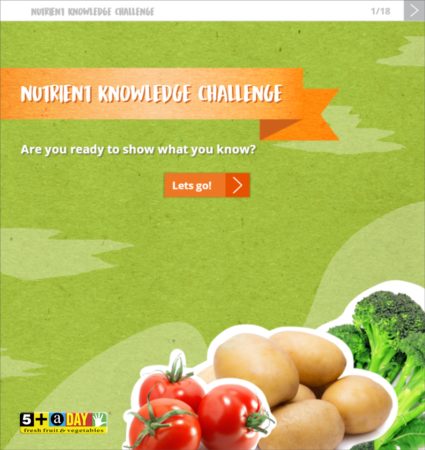Learning Opportunity 1: What are nutrients?
In this initial learning opportunity, students will start to explore the nature of nutrients in food, especially fresh fruit and vegetables. They will undertake an inquiry of their own choice to broaden their knowledge and delve more deeply into the sources of nutrients and their value to our bodies and health.

Learning Intentions

Students will:
- discuss what they understand by the term ‘nutrient’
- explore different kinds and categories of nutrients
- understand that nutrients are essential for good health, leading into the focus for learning opportunity 2
Possible Achievement Objectives
Health and Physical Education: Level 5
PERSONAL GROWTH AND DEVELOPMENT
Students will:
- describe physical, social, emotional, and intellectual processes of growth and relate these to features of adolescent development and effective self-management strategies
Science: Level 5
LIFE PROCESSES
Students will:
- identify the key structural features and functions involved in the life processes of all plants and animals
Preparation
Materials
For this and other lessons, there is a range of resources to use to prepare for the topic, and where appropriate, to share with students.
- Nutrient Knowledge Challenge: Before the lesson, work through the Nutrient Knowledge Challenge, so you are familiar with the interactivity and the content, and decide what technology you’ll use to engage the students.
- Nutrient Fact Files (Chewing the fat, The truth about protein, Carbs for energy, Vital vitamins, Mighty minerals)
- Nutrient Tree: Check out the Nutrient Tree that will inform an activity later in the lesson
Key Vocabulary
During this learning opportunity, key terms are used. Click on an underlined word to view a definition. You can define and explore these terms in context as you discuss this topic with your students.
The Learning Opportunity
This learning opportunity contains suggestions for helping students begin to understand the nature of nutrients in food. You can adapt the approach and activities, as needed, to support your students as they carry out their inquiries. Your role is to help your students generate rich questions about the topic of what nutrients are, rather than simply providing them with information.
Note: As a part of every learning opportunity, you can reinforce the message that eating 5+ A Day fresh fruit and vegetables is an important part of making healthy lifestyle choices.
To begin the learning opportunity, write the word nutrient on the board and ask students:
- What does this word mean to you?
- Think about where you see the term nutrient. How would you use it in a sentence?
Students may suggest a range of examples, such as:
“This is a nutrient-packed health bar.”
“Make sure you get your daily dose of nutrients.”
“That was a nutritious meal.”
- What nutrients can you name? (protein, carbohydrate, fat, vitamin, mineral)
- Where might you find that nutrient? Note that students may talk about the nutrients needed by plants and animals but guide the conversation to focus on human nutrition.
Nutrient groups
Next, divide the class into small groups and allocate the Nutrient Fact Files (Chewing the fat, The truth about protein, Carbs for energy, Vital vitamins, Mighty minerals), one per group. Students can either view onscreen or you can print copies for them. Have the students read their fact file together and discuss it, then report verbally back to the class, stating:
- What is your nutrient?
- Where is it found?
- Why is it important?
- What does it do?
It would also be useful for students to discuss the differences between vitamins and minerals to reinforce their understanding of the functions of these two types of nutrients.
Nutrient Knowledge Challenge
Next tell the students that they’re going to work together to find out exactly how much they know about nutrients by doing the Nutrient Knowledge Challenge (click on the image below to download and play). The aim is to draw on prior knowledge to build the class’s collective understandings about nutrients.
If laptops or tablets are available, this can be done in pairs or small groups. Or to involve the whole class, this can be done collaboratively using an IWB. It’s important that you familiarise yourself with this activity prior to introducing it to the class. It involves interactivity to engage students in their exploration.
On completion, ask the students:
- What did you learn?
- What surprised you?
- What questions do you still have?
Write students’ questions in a ‘parking lot’ on the board.
Now ask:
- In what other ways can you get nutrients apart from foods? (supplements)
- How do you usually take them? (capsule or powder)
Discuss with students the pros and cons of taking supplements. There are many supplements available but the best way to get all the vitamins and minerals you need is to eat a healthy balanced diet, which includes plenty of fresh fruit and vegetables. Food contains compounds like antioxidants, fibre, and phytochemicals, which work together with vitamins and minerals to keep you healthy.
A supplement provides a large amount of a vitamin or mineral. Scientific studies have discovered that taking a supplement isn’t as effective as eating food that contains this vitamin or mineral. In some cases, it can be beneficial to take a supplement, for example, if you are low in iron, you could take an iron supplement, but your doctor would usually recommend this.
Nutrient Tree
By this point, students will have started to gather a body of understanding about nutrients, and may have raised questions about their sources and functions. A final step before giving students the opportunity to begin an inquiry is to look briefly at how nutrients are grouped into macronutrients and micronutrients, building on their earlier discussion of nutrient groups.
Ask the students to work in small groups. Give them sets of the Nutrient Fact Files and ask them to create a tree showing a 'hierarchy of nutrients' under a starter like the one below. As they work, circulate, question, and respond to clarifying questions from the students.
You can click on this example of a Nutrient Tree to enlarge, download, and print.
Student inquiries
Based on the students’ experiences and conversation in this learning opportunity, ask them to think of questions that will extend their understanding and act as the focus for an inquiry that they can take on independently or in pairs. They could choose to use a question from the parking lot if it is rich enough to support an inquiry.
Whatever students choose to do, they need to use a rich, open question as a catalyst, and aim to present their findings to the class clearly and concisely. The intention is that these activities can be undertaken outside of class time and presented at the beginning of the next learning opportunity.
Diving Deep
Students could investigate a specific nutrient from the following list – dietary fibre, vitamin A, vitamin C, vitamin E, vitamin K, folate, potassium, calcium, iron, and magnesium. They can formulate questions around the areas they want to investigate, for example:
- Which fruit and vegetables deliver the largest amount of that nutrient?
- How much do you need a day?
- Can you get too much of that nutrient?
- Is it available as a supplement?
- Why is it important for our health?
Students can use the sources on the information hub, as well as doing their own research on the internet. Encourage them to report back to the class in innovative ways, such as a news report, a Q & A session, or a biography of the nutrient.
Reflection
To finish, allow time to reflect on the learning outcomes and to talk and share ideas that are still unclear.
In reflecting on this learning opportunity, the discussion will focus on:
- the definition of 'nutrient'
- macronutrients and micronutrients
- foods that deliver essential nutrients
If there is time, explain that the next learning opportunity will focus on why nutrients are important for good health.


